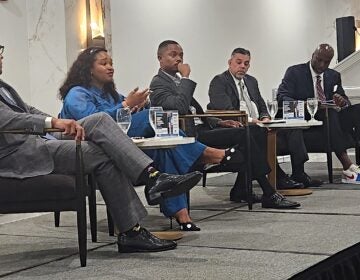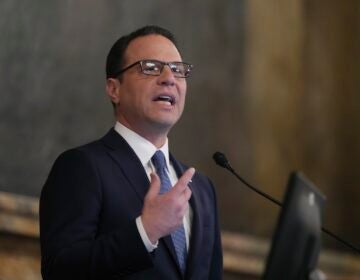At last, breaking ground on the Pa. Turnpike to I-95 interchange

Gov. Tom Corbett and other officials picked up shovels for a photo op at the opening ceremony for the Pennsylvania Turnpike to I-95 interchange.
Gov. Tom Corbett and other officials kicked off construction on something many in the region thought they would never see—a highway interchange linking the Pennsylvania Turnpike to Interstate 95.
The turnpike and I-95 meet northeast of Philadelphia on any map, but turnpike motorists looking to get onto the interstate have long cursed and railed as they see it passing overhead with no way to reach it. Instead, drivers must travel Route 1 or local roads to get from the Pennsylvania Turnpike to the interstate and vice versa.
But a construction plan in the works since the 1980s is finally under way this year, and it could mend what has become a symbol of regional dysfunction.
At a ceremony last week, Corbett said the new interchange is restoring logic to an illogical highway system.
“It only makes sense,” he said. “Connecting the two major arteries in Southeastern Pennsylvania, so that we can get our people, our goods, our services, north and south, east and west—without having to get off the roads, without having to sit in traffic.”
Despite the interchange success story, many other roadways in the state still require major improvements. Corbett’s transportation package failed to pass the legislature earlier this summer, but at the opening he challenged state lawmakers to approve a bill before their winter recess.
The national transportation research group TRIP estimates that 37 percent of Pennsylvania’s local and state roads are in poor condition or worse. The group says 42 percent of its bridges are in need of repair or replacement.
A short history of a would-be interchange
When I-95 was completed through Bucks County in 1969, it was illegal to use federal funds to connect an interstate highway to a toll road, as had been planned originally.
But in 1982, the federal government decreed that I-95 and the turnpike be connected. Pennsylvania secured federal money for the proposed interchange in 2004, nearly two decades later.
Lt. Gov. James Cawley admitted that well into the 1990s, he and other Bucks County officials of the time were “against [the planned interchange] before we were for it” due to concerns about how it might affect the local community.
Now, he said, designers have landed on a plan that accommodates Bucks County and the rest of Pennsylvania, as well as the needs of travelers along the eastern seaboard.
Officials at the opening predicted commuters should have a smoother ride between Philadelphia and New Jersey when the first stage of construction is complete in 2018.
The construction will cost nearly $500 million in toll revenue and federal grants.
WHYY is your source for fact-based, in-depth journalism and information. As a nonprofit organization, we rely on financial support from readers like you. Please give today.




